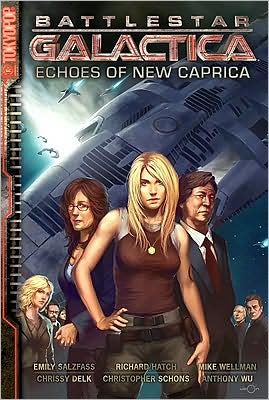- Comics
- Comics Reviews
- Manga
- Comics Reviews
- European Comics
- News
- Comics News
- Press Releases
- Columns
- Spotlight
- Digital Comics
- Webcomics
- Cult Favorite
- Back Issues
- Webcomics
- Movies
- Toys
- Store
- More
- About
By Leroy Douresseaux
April 20, 2009 - 09:12
 |
| Battlestar Galactica: Echoes of New Caprica cover image is courtesy of barnesandnoble.com. |
Action/Sci-Fi; Rated “T” for “Teen-Age 13+”
Battlestar Galactica, the Sci-Fi Channel series that debuted in 2004 (after a 2003 pilot miniseries), recently made its debut as a global manga from publisher TOKYOPOP with the publication of Battlestar Galactica: Echoes of New Caprica. An anthology of three stories, Echoes of New Caprica’s tales apparently take place at various times during the series’ second and third seasons. [I’ve only seen a few episodes of this series, and am therefore mostly unfamiliar with it.] The popular and acclaimed serial drama and military science fiction followed the journey of the last surviving human colonists of the Twelve Colonies of Kobol after their nuclear annihilation by the robot Cylons.
“Teacher’s Pet” (written by Emily Salzfass and drawn by Chrissy Delk) takes place after the Cylons invade New Caprica. Former President of the Colonies, Laura Reslin is a teacher struggling to educate her young students with a “human-centric” curriculum, which the colony’s Cylon rulers are against. Meanwhile, human rebels, the Cylons, and their human collaborators are engaged in a war that puts the children in the middle of the conflict – often as pawns.
The second and third stories take place after the evacuation of New Caprica. Written by Richard Hatch (who starred in the original late 1970s Battlestar Galactica and had a recurring role on the new series) and drawn by Christopher Schons, “Shelf Life” finds Hatch’s new Galactica character Tom Zarek forming a secret squad to try and execute any human suspected of collaborating with the Cylons on Caprica. When an old friend becomes a target of this tribunal, Zarek isn’t sure if he can follow through with this mission.
Finally, in “Visitation,” Kara “Starbuck” Thrace finds Kacey, the child that was once her daughter, in a Galactica shantytown. Kara is determined to remove the child from her real mother, whom Kara considers careless, and her actions to take the child could cost her dearly.
The stories in Echoes of New Caprica are surprisingly (to me) thoughtful and introspective, but apparently so is the series. The three stories here address such war time issues as loyalty to race, collaborating with enemy, family, internment camps, combat, terrorism, etc., but the reader might never notice this because the drama is so engaging. All the character conflict and drama are subtly played, and the suspense keeps the mind so engaged that the reader might forget all the themes and real world issues these narratives tackle.
It’s a shame that the art doesn’t live up to the ambitious stories and scripts. The three artists here are competent storytellers, but they range from woeful to merely adequate in terms of composition and draftsmanship. These artists don’t sabotage the stories, but if a publisher is going to adapt an acclaimed television series like Battlestar Galactica, it should use better artists than these. Still, fans of the series may like Battlestar Galactica: Echoes of New Caprica, and this book might make newcomers look for the DVDs.
B